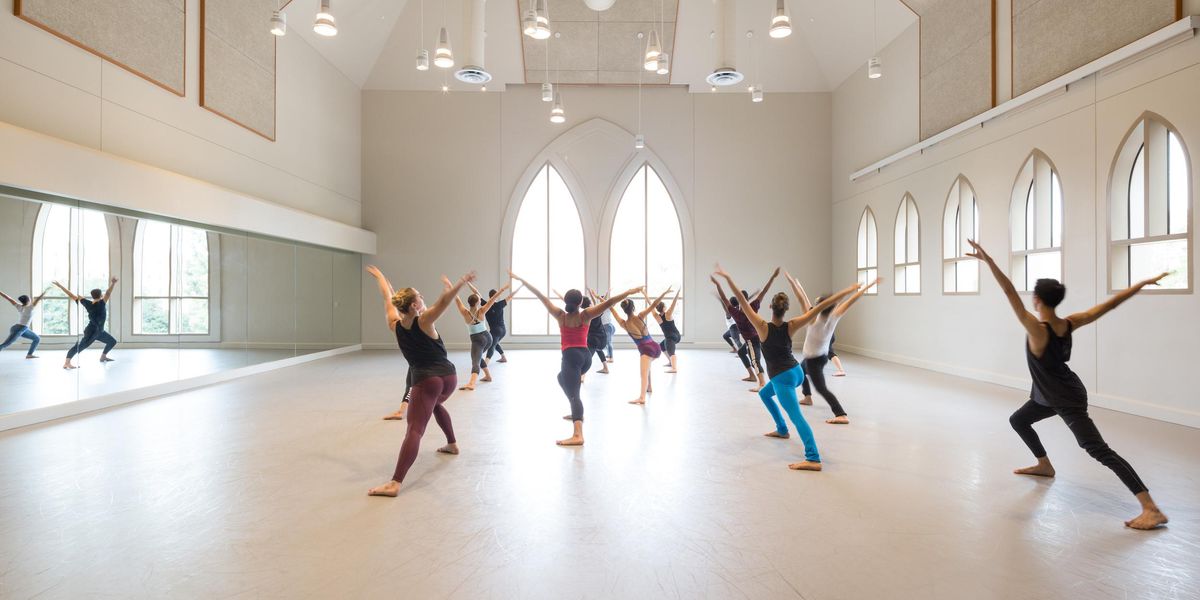On Broadway: Making It Up
Idina Menzel and company members. All photos by Joan Marcus, Courtesy
If/Then.
If there are any great tappers in the ensemble of If/Then, the audience can’t tell. If there’s anyone with a dazzling balletic line, no one will know. What’s clear is that there are eight triple threats singing the demanding score by the Pulitzer Prize–winning Tom Kitt and Brian Yorkey (Next to Normal), dancing Larry Keigwin’s casually pervasive choreography and portraying dozens of New Yorkers who intersect in one way or another with Idina Menzel’s lead character, a city planner newly returned to New York after her divorce.
As two of her possible destinies unfold simultaneously, the ensemble weaves in and out of the stories without ever stepping into anything that could be isolated as a “number.” Keigwin’s choreography has been seamlessly integrated into the show, and ensemble members Stephanie Klemons, Curtis Holbrook and Joe Aaron Reid say that the process asked more of them than any of their previous Broadway gigs.
Klemons, a native New Yorker who grew up in New Jersey, has In the Heights and Bring It On on her resumé and regularly assists Andy Blankenbuehler. Holbrook grew up tapping at his mother’s San Antonio dance studio and booked his first musical, Footloose, at 17, subsequently dancing in All Shook Up, Xanadu and West Side Story. And Reid performed in Chicago and Catch Me If You Can, among others, after training in the Rochester, New York area. Keigwin has some Broadway experience, but he’s spent the last 10 years running his popular contemporary dance group, Keigwin & Company, so he came to If/Then with a somewhat unconventional pedigree.
His approach, Klemons says, “was very different for us.” She points out that choreographers who work mainly with their own dancers over the years develop a kind of shorthand; for a Broadway ensemble working together for the first time, “it was challenging to understand his language at times.”
Reid, noting that If/Then is his sixth Broadway show, says previous choreographers all relied on familiar Broadway terminology. “They say, ‘Do this, do this, do this,’ and I will regurgitate that. With Larry it was a matter of getting him to really express what he wanted to see and feel and try to translate that into what I know how to do.”
Holbrook didn’t mind not hearing “Do this, do this, do this.” Most of the time, he says, Broadway choreography exists before rehearsals begin. “You come in and they tell you exactly where you’re going and exactly what the phrase of movement is going to be. You’re there to execute that as best you can. With Larry, it’s really been about ‘What is the vocabulary of the show?’ It took some time to figure it out, and it was actually pretty thrilling to be a part of that process.”
Klemons agrees. “He asked of us something really generous: He asked us to be creative performers, not just parakeets—‘Here’s an idea, now you run with it.’ And while we’re not used to that in this world, it was really generous of him to say, ‘I trust that I’ve hired people who can take this idea and complete it for me.’ ”
Says Reid, “At the end of the day, it was very rewarding, because I feel I grew as a performer. I don’t think I’ll go work in the concert dance world anytime soon, but my eyes were opened. The dancers in the show got to work with a concert-dance mentality and really try to feel each other. Instead of ‘It’s-a five, six, seven, eight, hit this, go,’ we learned to live and breathe in an organic kind of world.”
The process was at times arduous. Director Michael Greif and the authors didn’t want the dance to be too dance-y, and Keigwin was frequently asked to simplify the choreography. “It had to be movement that Idina or Anthony Rapp, who are really singer-actors, could join in,” says Klemons, “and that dancers like myself could do right next to them and not look like we were over-dancing it. We spent a lot of time re-choreographing.”
But all three agree that it was worth it. “In other shows,” Reid says, “it’s about the principals doing their scenes, and then you come out, do a song and dance and go away. The great thing about this is we’re dancing, but it’s not a chorus where everyone has to look alike.”
“What we’re doing,” notes Holbrook, “may have actually come from me, or one of the other dancers.”
From Backstage
Ensemble:
5 men, 3 women
Swings:
2 men, 2 women
Number of roles they understudy:
13
Choreographer:
Larry Keigwin
Dance captain:
Stephanie Klemons
Warm-up:
None—even Klemons doesn’t bother. “Since it’s not physically demanding, there really is no warm-up. I do not, nor have I seen anyone else, warm up.”
Above: Keigwin watching a rehearsal.




